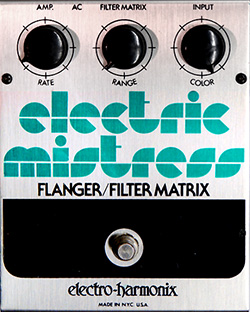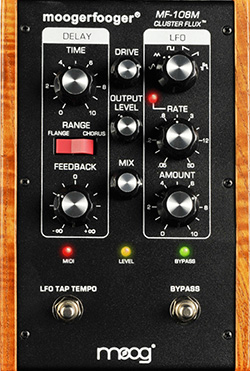![]()
It seems to have become a common misconception that guitar fuzz boxes and distortion pedals predate more eloquent effects, such as phasing and flanging.
OK, tremolo and spring reverb were originally guitar amp features, and fuzz and distortion evolved from damaged loudspeakers, impedance mismatches and voltage sag. But effects that were developed in the recording studio are the result of earlier experimentation, exploration and serendipity.
Few young guitarists realise that the Stompbox Big Bang (SBB) was ignited in the recording studio. The handful of effects that were created in the early moments of the SBB have since blossomed into a still-expanding universe of almost infinite variation – which itself has collided with that of fuzz-overdrive-distortion. It’s a weird and wonderful place, but you wouldn’t want to have to map it.
So let’s try.
The first dedicated tape echoes date back to the 1950s, while the first fuzz pedals appeared in the mid-1960s. Alongside (tape) echo, (plate and spring) reverb, double tracking and flanging marked the dawn of the effects era.
The gentle art of flanging itself is widely attributed to Beatles producer George Martin and Abbey Road engineer Ken Townsend, when attempting to take the manual work out of double-tracking vocals. The result was ADT, or Artificial Double Tracking. Martin attributes the term flanging to John Lennon, after giving him a cod-science description of how this was achieved.

In fact, David S Gold and Stan Ross of Gold Star Studios in Hollywood claim to have made the first commercial recording to use flanging with ‘The Big Hurt’ by Toni Fisher, which was recorded in late 1959 and became a US hit in early 1960. Flanging is also in evidence in the opening of The Ventures’ 1962 cover of The Tornados’ ‘Telstar’, the Small Faces ‘Itchychoo Park’ single (1967), Jimi Hendrix’s Axis: Bold as Love album (1967), and Status Quo’s ‘Pictures of Matchstick Men’ (1968).
Flanging first appeared in stompbox form in the 1970s, with units from MXR, Electro-Harmonix and ADA each offering its own circuitry and character. Its arrival was nicely set up by the release of the Maestro PS-1 Phase Shifter in 1971 – a new effect that had an immediate impact on the sound of the electric guitar, and opened the door for its near neighbour.
My first flanger was my Mistress.
It was an original Electro-Harmonix Electric Mistress – there was nothing deluxe or digital about it (those were to come later), and it was great. Noisy, yes. Battery eater, absolutely. And great. I used it relentlessly to lend a surprisingly workable Leslie effect to a Crumar Organizer. Better than a Leslie, it allowed me to manually control the ramp-up and ramp-down times. There’s a surprising level of drama to be tapped there.
Not everyone shares my flanger passion, however, as a post on the Strat Talk bulletin board delightfully demonstrates: ‘The first thing to know about flangers is that, if you have a set of 30 songs, you can only use the flanger on one of them or your audience will get sick of it. The second thing is it doesn’t matter that much what you play because it is all going to sound like the flanger. The third revelation is that, after the first and second, you’re going to put the flanger in the closet and forget about it.’
Harsh.
I doubt that Andy Summers would agree, having built his role in the Police around his pedalboard with extensive use of an original Electric Mistress and delays. Or David Gilmour, who used his Mistress from the late 1970s into the 1980s, and on the Wall and Pulse tours. Interestingly, both players had Pete Cornish build them custom pedalboards incorporating these and other pedals, solving both noise and power issues. Another notable flanger user is Eddie Van Halen, who has put his name to Signature Series versions of MXR’s phaser and flanger pedals.
 Since ADA, MXR and Electro-Harmonix laid the groundwork, there have been many, many flangers and extensive debate over their relative merits. I thought I was moving upmarket when I replaced my Mistress with a (Japanese) Boss BF-2 in the eighties, but found myself with a different ‘flavour’ of flange as well as a modicum of regret.
Since ADA, MXR and Electro-Harmonix laid the groundwork, there have been many, many flangers and extensive debate over their relative merits. I thought I was moving upmarket when I replaced my Mistress with a (Japanese) Boss BF-2 in the eighties, but found myself with a different ‘flavour’ of flange as well as a modicum of regret.
Today, we are spoilt for choice, and there are flangers to suit all depths of pocket. Among them is a pretty convincing ElecMistress analogue clone from Mooer. Headlining other options is the beautiful Moogerfooger MF-108 Cluster Flux (also analogue), with Strymon’s Orbit, HBE’s Frostbite (an ADA clone) and the TC Electronic Vortex among others both analogue and digital.
Bringing stompbox flanging cycling back to its roots in tape manipulation, through-zero flanging has recently been a pretty hot topic. As studio flanging practitioners will know, TZF replicates the ‘null’ at the end of the flanging cycle where the audio is completely cancelled. Once a sought after but elusive aspect of pedal flanging, this is now becoming more commonplace, with TZF models included in boutique analogue boxes and digital effects modellers – including the Orbit and Vortex already mentioned, and Eventide’s powerful ModFactor.
Today, flanging has multiple personalities. Where studio flanging still seems to work best as applied on those early recordings, giving drums or a full mix an otherworldly tonal moment in a mix, stompbox flangers have taken those roots and commoditised them, giving guitarists and keyboard players a palette of textures to play with.
Flanging remains high among my favoured effects, whether applied in the studio control room or underfoot. And much as I’ve enjoyed my own experiments with various flanging stompboxes, I do so miss my Mistress.

